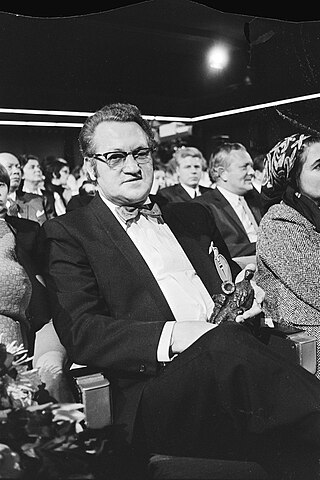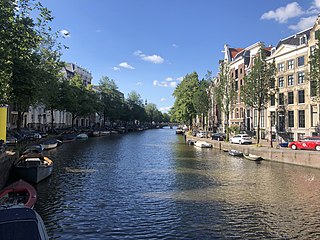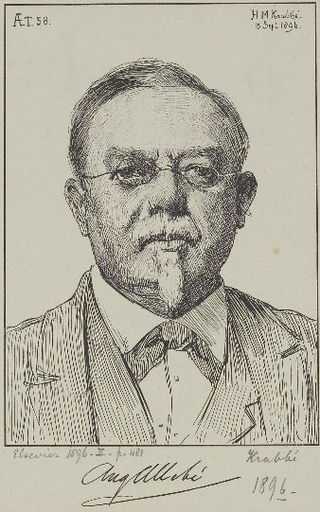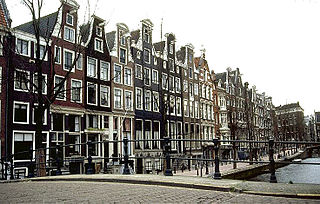
Pieter Goemans (1925-2000) was a Dutch composer, probably best known for having written the classic song "Aan de Amsterdamse grachten".

Pieter Goemans (1925-2000) was a Dutch composer, probably best known for having written the classic song "Aan de Amsterdamse grachten".
Goemans was born on 6 June 1925 in Amsterdam. The son of a diplomat, his father forced him to write under a pseudonym to avoid any association between the family and the popular entertainment industry. [1] Under the name Peter Shott he wrote, in 1949, the song "Aan de Amsterdamse grachten"; [2] Goemans was inspired to write the song in 1949 while walking across the bridge where the Prinsengracht and the Leidsegracht intersect. [3] It wasn't supplied with sheet music and recorded until 1956, when an arrangement was written by pianist Dick Schallies (then a member of the Metropole Orkest) since (Schallies explained) Goemans couldn't write music. [3] Henk Visscher, singer as well as guitar and bass player with Johnny Kraaijkamp, was the first to sing and record the song, [4]
In the 1960s Goemans was one of the regular lyricists for Corry Brokken, translating foreign material. One of his tunes, "Bach bijvoorbeeld", was sung by Shirley Zwerus and produced by Willem Duys used as the opening tune for his weekly radio program. In 1970, Hearts of Soul won the Nationaal Songfestival with the Goemans song "Waterman"; the song finished seventh at the Eurovision Song Contest 1970. [5]
Goemans died on 8 July 2000. [6] The bridge on which "Aan de Amsterdamse grachten" came to him was marked with a plaque and later named for him; his ashes were spread over the Prinsengracht. [7]

Johnny Jordaan was the pseudonym for Johannes Hendricus van Musscher, a Dutch singer of popular music, in particular the genre known as levenslied, a Dutch variety of the French chanson. He was well known for his songs about the city of Amsterdam, especially the Jordaan district, which he sang in a typical "hiccuping Mokum vibrato", "Mokum" being the Hebrew-derived nickname for the Amsterdam inner city area. In the 1950s, Johnny Jordaan rose almost instantly to the level of national celebrity and became the "uncrowned king of the Jordaanlied", and his hit song "Geef mij maar Amsterdam" is one of the songs Amsterdammers identify with most.

The National Maritime Museum is a maritime museum in Amsterdam in the Netherlands.

Amsterdam Impressionism was an art movement in late 19th-century Holland. It is associated especially with George Hendrik Breitner and is also known as the School of Allebé.

The Keizersgracht is a canal in Amsterdam, the Netherlands. It is the second of the three main Amsterdam canals that together form the Grachtengordel, or canal belt, and lies between the inner Herengracht and outer Prinsengracht.

Amsterdam, capital of the Netherlands, has more than 100 kilometers (62 mi) of grachten (canals), about 90 islands and 1,500 bridges. The three main canals, dug in the 17th century during the Dutch Golden Age, form concentric belts around the city, known as the Grachtengordel. Alongside the main canals are 1550 monumental buildings. The 17th-century canal ring area, including the Prinsengracht, Keizersgracht, Herengracht and Jordaan, were listed as UNESCO World Heritage Site in 2010, contributing to Amsterdam's fame as the "Venice of the North".

Weesperplein is an underground metro station in the city centre of Amsterdam, Netherlands. Served by metro lines 51, 53 and 54 of the Amsterdam Metro, the station was constructed using caissons with a length and width of 40 metres (130 ft). The station has two floors, with the upper floor featuring a station hall with stores and the lower floor containing the tracks. The first metro train went through the station in January 1977. Extensive tests were carried out in September of the same year before the station opened on 16 October.

August Allebé was an artist and teacher from the Northern Netherlands. His early paintings were in a romantic style, but in his later work he was an exponent of realism and impressionism. He was a major initiator and promoter of Amsterdam Impressionism, the artist's association St. Lucas, and the movement of the Amsterdamse Joffers. Amsterdam Impressionism – sometimes referred to by art historians as the School of Allebé – was the counterflow to the very strong Hague School in the movement of Dutch Impressionism. As a professor at the Royal Academy of Amsterdam he fostered a cosmopolitan attitude toward art and the promotion and motivation of his students, and provided a significant stimulus to developments in modern art.
Pi Vèriss, born Piet Visser, was a Dutch songwriter and composer probably best known for writing the Johnny Jordaan hit "Geef mij maar Amsterdam", an immensely popular Jordaanlied. He was awarded the Golden Harp in 1986 for his entire body of work.

"Aan de Amsterdamse grachten" is a Dutch song by Pieter Goemans. It was written in 1949 but not recorded until 1956, and many times more since then. It is one of the standard songs celebrating the city of Amsterdam, and one of the best-known and most popular songs in the Netherlands.

The Prinsengrachtconcert is an annual open-air concert of classical music held annually in August since 1981 on the Prinsengracht in Amsterdam. The orchestra is situated on a pontoon anchored in front of the Hotel Pulitzer; much of the audience watches and listens from boats. Traditionally the concert is closed with a rendition of one of the city's anthems, "Aan de Amsterdamse grachten".

Tol Hansse was a Dutch singer and musician. He was the son of cabaret artist Jacques van Tol. Because of his father's history of collaboration during World War II he changed his name. Hansse played trumpet accompanying Tom Manders, and was in the rock band The Sharks with Clous van Mechelen. He had a modestly successful career as a singer-songwriter in the 1970s. Van Mechelen wrote the music for his biggest hit, "Big City" (1978), still considered a classic song about Amsterdam. He never rivaled the success of that song again, and died of lung cancer in Heerhugowaard in 2002.

AVROTROS is a Dutch radio and television broadcaster that is part of the Dutch public broadcasting system. It was founded in 2014 as the result of a merger between the Algemene Vereniging Radio Omroep (AVRO) and the Televisie Radio Omroep Stichting (TROS). The name AVROTROS has been used for jointly produced programmes since 1 January 2014. Since 7 September 2014, all existing AVRO and TROS programmes have also been broadcast under the name AVROTROS.

Isabella Henriette van Eeghen, usually cited as I. H. van Eeghen, was a Dutch historian who worked for the Stadsarchief Amsterdam.

We Are Here is a collective of migrants based in Amsterdam, the Netherlands, which campaigns for human rights for its members and all undocumented migrants. The asylum seekers have in many cases had their applications to remain in the Netherlands denied but they either cannot go back or refuse to return to their country of origin. They demand access to social services such as medical care and housing. The group formed in 2012 and by 2015 contained over 200 migrants from around 15 countries.

The Leidsegracht is a canal in Amsterdam, the Netherlands. It is a cross-canal in Amsterdam-Center that connects Herengracht, Keizersgracht, Prinsengracht and Lijnbaansgracht and flows into the Singelgracht at Marnixstraat.

The Anjeliersgracht is a former canal in the Jordaan neighborhood of Amsterdam. After being backfilled in 1861, it is now Westerstraat.

De Basis, formerly known as the Basic Income Party, is a minor political party in the Netherlands, which advocates for the implementation of a universal basic income. The party registered with the electoral council on 9 December 2013.

Arnold van den Bergh was a Dutch legal notary based in Amsterdam. He was a well-known and high-profile lawyer, one of six Jewish notaries operating in Amsterdam. Van den Bergh contributed to the field of social work in the Netherlands, and was widely known in Amsterdam outside of the Jewish community.
Dion Cuiper, known professionally as Dion Cooper, is a Dutch singer-songwriter. He is set to represent the Netherlands in the Eurovision Song Contest 2023 alongside Mia Nicolai with the song "Burning Daylight".